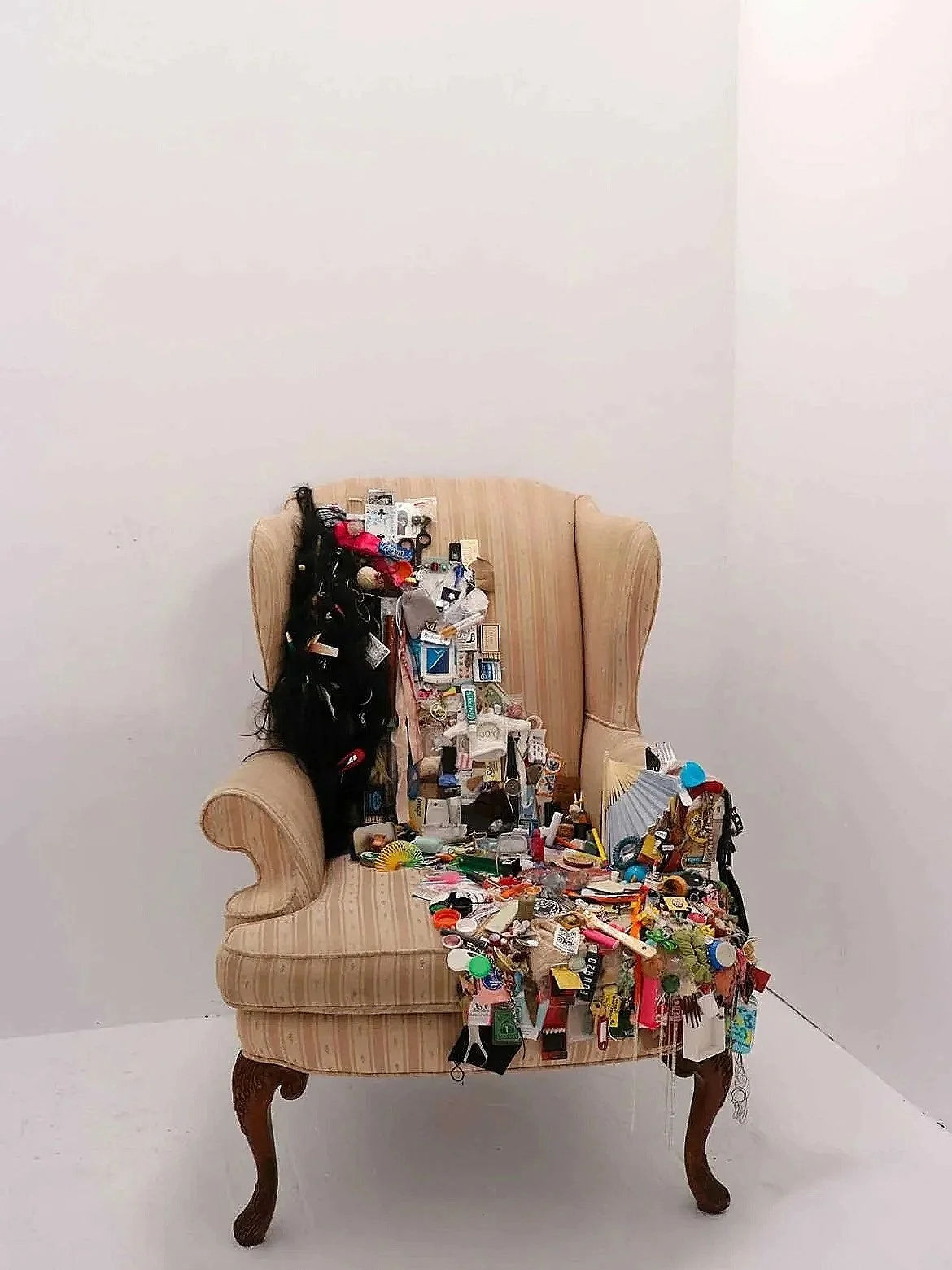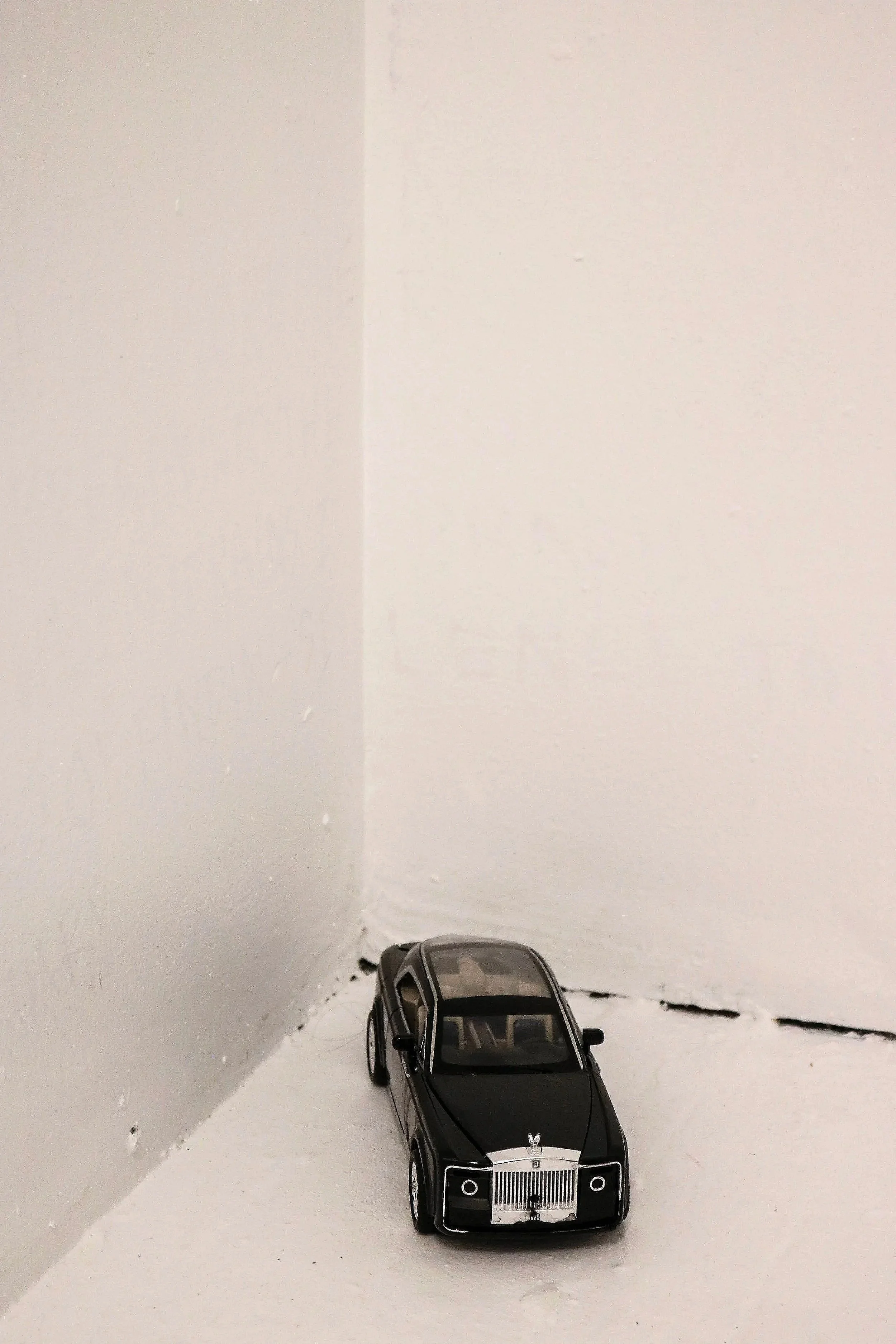 Image 1 of 5
Image 1 of 5

 Image 2 of 5
Image 2 of 5

 Image 3 of 5
Image 3 of 5

 Image 4 of 5
Image 4 of 5

 Image 5 of 5
Image 5 of 5






Exit 111
Mixed media installation
Upholstered char, found objects, sewing pins
Exit 111 is an installation centered around a weathered wingback armchair, its light pink upholstery traced with cream stripes and tulip-adjacent trim—barely visible beneath a cascade of personal and found objects. Sourced from a woman in Bed-Stuy and marked by her cat’s scratches, the chair becomes both relic and reliquary. From the bottom right corner, a cluster of items—chocolate coin from Caroline, room key from Barcelona, Grammy’s rosary, bottle cap from a first date—spills upward, growing dense and immovable. The seat, once inviting, is overtaken, rendered unusable.
This accumulation is not incidental; it mirrors the congested intimacy of the artist’s grandmother’s mattress, where emotional memory became inseparable from material life. Here, the chair is transformed into a poetic structure—a visual narrative built from fragments of daily life, where the ordinary becomes a charged site of ritual, memory, and attachment. Each object carries the intangible weight of connection, serving as a symbol of both what was once present and what can never be fully reclaimed.
Drawing on the visual language of loneliness passed down through generations, Exit 111 investigates the emotional residue of inherited objects and the way they shape identity. Rooted in psychoanalytic theory—particularly the concept of object transference—the work positions these artifacts as vessels for repressed self-fragments and unmet needs, silently mediating the tension between holding on and letting go. The installation becomes a ritual of recontextualization, transforming clutter into clarity, loss into language, and pain into a tender act of preservation.
Exit 111 asks: What does it mean to hold space for what once was? Can honoring the emotional resonance of the everyday become a way to liberate ourselves from its grip? Through this quiet choreography of arrangement and obstruction, the work becomes a meditation on memory as material, and on the object as a silent witness to personal and collective history.
Mixed media installation
Upholstered char, found objects, sewing pins
Exit 111 is an installation centered around a weathered wingback armchair, its light pink upholstery traced with cream stripes and tulip-adjacent trim—barely visible beneath a cascade of personal and found objects. Sourced from a woman in Bed-Stuy and marked by her cat’s scratches, the chair becomes both relic and reliquary. From the bottom right corner, a cluster of items—chocolate coin from Caroline, room key from Barcelona, Grammy’s rosary, bottle cap from a first date—spills upward, growing dense and immovable. The seat, once inviting, is overtaken, rendered unusable.
This accumulation is not incidental; it mirrors the congested intimacy of the artist’s grandmother’s mattress, where emotional memory became inseparable from material life. Here, the chair is transformed into a poetic structure—a visual narrative built from fragments of daily life, where the ordinary becomes a charged site of ritual, memory, and attachment. Each object carries the intangible weight of connection, serving as a symbol of both what was once present and what can never be fully reclaimed.
Drawing on the visual language of loneliness passed down through generations, Exit 111 investigates the emotional residue of inherited objects and the way they shape identity. Rooted in psychoanalytic theory—particularly the concept of object transference—the work positions these artifacts as vessels for repressed self-fragments and unmet needs, silently mediating the tension between holding on and letting go. The installation becomes a ritual of recontextualization, transforming clutter into clarity, loss into language, and pain into a tender act of preservation.
Exit 111 asks: What does it mean to hold space for what once was? Can honoring the emotional resonance of the everyday become a way to liberate ourselves from its grip? Through this quiet choreography of arrangement and obstruction, the work becomes a meditation on memory as material, and on the object as a silent witness to personal and collective history.